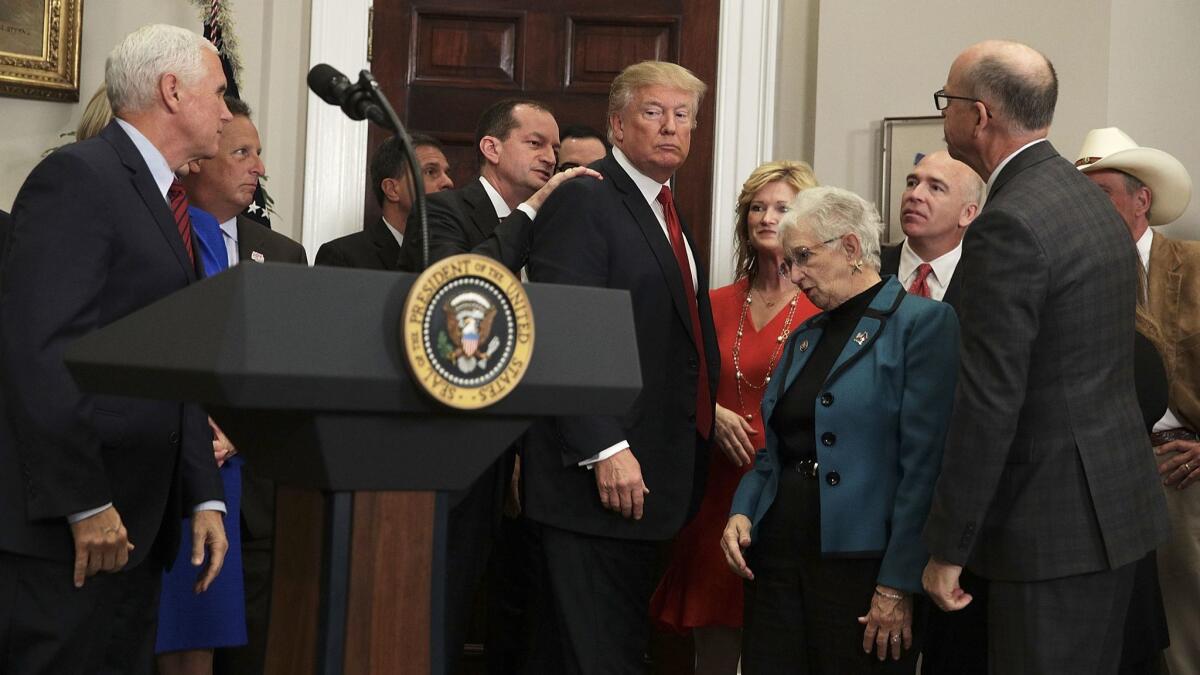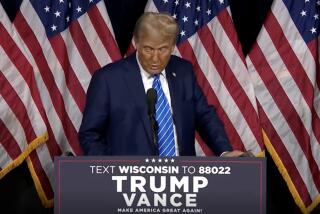Column: Trumpcare Sabotage 2: Trump’s executive order will undermine Obamacare, but not the way you think

President Trump turned his sabotage of the Affordable Care Act up to top volume Thursday, chiefly by issuing an executive order instructing three major federal agencies to look into ways to siphon healthy people out of the ACA exchanges. Combined with a second order ending federal payments to insurers to cover deductibles and co-pays for low-income households, the executive order marked a black day for the American healthcare system.
The executive order in particular could do major damage to the healthcare market — but not in the way that many people anticipate. If fully implemented, it’s true, the order is likely to lead to higher premiums in the future for hundreds of thousands of Americans and fewer consumer protections for millions of others, many of whom won’t know what they’ve lost until they need it.
But the more significant damage may well be a loss of confidence in the system among insurers and customers. That effect would become magnified over time. Without intercession by Congress, the American healthcare landscape would move back toward what it was before the ACA was enacted in 2010.
By itself, this executive order is rather less than meets the eye. It does not engage in actual deregulation or reform of any kind
— Conservative economist Yuval Levin
That was a fragmented system in which most people got their health coverage from employers; another large segment relied on government programs, especially Medicare and Medicaid; and the remainder were stuck in the individual market. In the new world, the latter group would be further split between those eligible for government subsidies, who would do all right, and those earning too much to get subsidies, who would be creamed.
“The big losers of this system are the non-subsidy eligible individuals with chronic conditions that will bounce them from any underwritten pool,” writes David Anderson of Duke University, referring to the pool of people whose medical conditions bar them from cheap coverage. “The off-exchange/non-subsidized segment will death spiral …. This is the group that gets screwed.”
As Timothy S. Jost of Washington and Lee University observed, the executive order recited such perceived failures of the ACA as “rising premiums for ACA coverage, reduced insurer participation in exchanges, and reduced exchange enrollment,” without acknowledging that “many of the problems the individual market is experiencing are certainly due to actions the Trump administration has taken to undermine ACA coverage.”
Those actions include truncating the period for open enrollment this year while slashing marketing and outreach funding, so many enrollees will miss the shorter deadline; and reducing enforcement of the individual mandate, which requires even young and healthy individuals to carry coverage.
Trump’s executive order overlooks a fundamental fact about health coverage: Bringing it to more people costs money. You can’t reduce the overall costs just by moving people from one pool into another; you can only shift the costs around. In this case, Trump would reduce costs for healthy people by allowing them to go without many benefits; but that just imposes higher costs on others.
The executive order is the latest step in this process. So let’s examine it in detail.
The order calls on the Departments of Health and Human Services, Labor and the Treasury to start developing rules aimed at expanding the availability of association health plans and short-term insurance plans. Both are exempt from many federal health insurance regulations and some state rules. The underlying goal, Jost perceives, is to “siphon healthy people out of the ACA-compliant market, causing the risk pool to become … less healthy and more costly, possibly leading to collapse in some states.”
Giving healthy people more access to bare-bones plans at cheaper rates would be good for them, on the surface. But it would leave many of them exposed to catastrophic costs and the loss of coverage if they became sick or got injured, with fewer options for affordable coverage. And those who already have chronic or serious conditions would be stuck in the ACA market.
The executive order leaves wide open the time frame for regulatory changes, as well as details of what those regulations should be. That’s because any such changes would have to comply with the federal Administrative Procedure Act, which mandates that the agencies publish their proposed rules and accept and answer public comments before making them final.
Even anti-Obamacare conservatives don’t seem sure what to make of the executive order. “By itself, this executive order is rather less than meets the eye,” judged Yuval Levin of National Review. “It does not engage in actual deregulation or reform of any kind but rather calls upon the three relevant Cabinet departments to begin the process of doing so. And the order is very vague about what steps new rules should take.”
How long the drafting and comment process will take is utterly unknown. Certainly it means that changes won’t be in place for the 2018 insurance year, open enrollment for which starts in two weeks, on Nov. 1. Conceivably all the necessary comment periods could be completed in time for 2019, but that’s ambitious, especially if lawsuits intervene. (What are the chances?)
Some changes anticipated by the order could require new legislation; at the very least, the drafting agencies will have to navigate around existing laws, and not only the Affordable Care Act.
Take association health plans, which aimed to allow small employers that were members of professional or trade groups to band together to offer employee health plans. In the pre-ACA era, this gave those employers leverage to obtain favorable prices from insurers. Since the ACA leveled the playing field for individuals and small businesses, they weren’t needed much anymore.
Trump’s order calls on the agencies to find ways to expand the definition of these plans to encompass “common geography or industry.” The problem, however, is that such plans are subject to the Employee Retirement Income Security Act of 1974, or ERISA, as well as the Health Insurance Portability and Accountability Act, or HIPAA. These laws define association plans differently, but taken together they present powerful impediments to exempting those plans from federal consumer protection rules or state oversight.
Indeed, an effort by the George W. Bush administration to broaden the definition of association plans came to nought. National Review’s Levin, who was a staffer in the Bush White House, recalls that its lawyers concluded that expanding the definition required a change in the law, “which President Bush pressed Congress to enact, to no avail.” Jost observes that the legislation failed in the Senate because it was “opposed by over 1,000 state government, business, labor, consumer and physician and provider groups, including many small business organizations and chambers of commerce.”
The second major thrust of the executive order is to broaden access to short-term insurance. Under existing law, these policies can’t remain in place for more than three months and can’t be renewed by customers. They’re bridge policies aimed at covering people for short periods, between jobs, say. Trump’s order instructs the agencies to look for ways to allow the plans to cover longer periods and be renewed by the consumer.
But that would present pitfalls for many buyers. For one thing, the plans can exclude people with preexisting conditions. Under the ACA, they’re not considered qualifying coverage, so their policyholders are still subject to the individual mandate penalty of $695 or 2.5% of income, whichever is larger. Customers whose short-term policies run out in midyear wouldn’t be eligible to sign up for ACA coverage until the open-enrollment period for the following year, which means they’d be exposed to any medical bills they incur in the meantime.
They’re cheap to those who can get them, but they can be skimpy to the point of being junk insurance, with stringent benefit limits and exclusions for mental health or maternity care. One danger in this market is that some buyers may not understand how little they’re buying at their bargain rates. It’s one thing to buy junk insurance with your eyes wide open; it’s quite another to not realize you’ve bought it until you try to use it and are told, “Didn’t you know? We don’t cover that.”
Trump says his goal is to provide Americans with “more affordable healthcare choices,” but he’s playing a game of sleight-of-hand. It’s no challenge to make insurance more affordable if all you’re doing is cutting benefits and raising people’s risks. If Trump’s executive order gets put into practice, the choices for people most vulnerable to healthcare costs because they’re sick or injured — and even the healthiest twentysomethings today could find themselves in that category tomorrow — will get narrower and narrower, and their costs will go higher and higher. That’s not a good future for anybody.
Keep up to date with Michael Hiltzik. Follow @hiltzikm on Twitter, see his Facebook page, or email [email protected].
Return to Michael Hiltzik’s blog.
More to Read
Inside the business of entertainment
The Wide Shot brings you news, analysis and insights on everything from streaming wars to production — and what it all means for the future.
You may occasionally receive promotional content from the Los Angeles Times.











